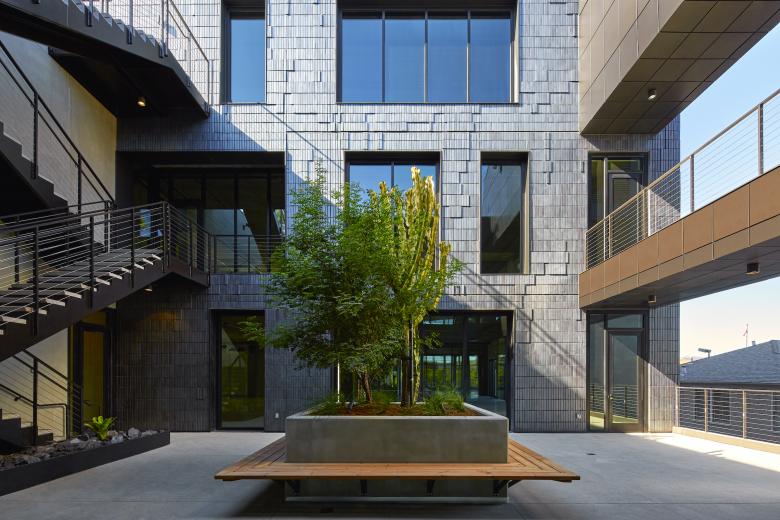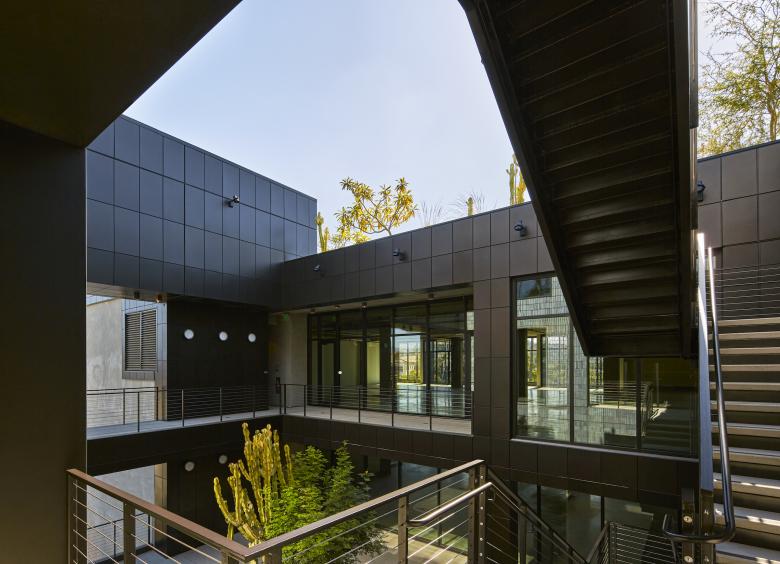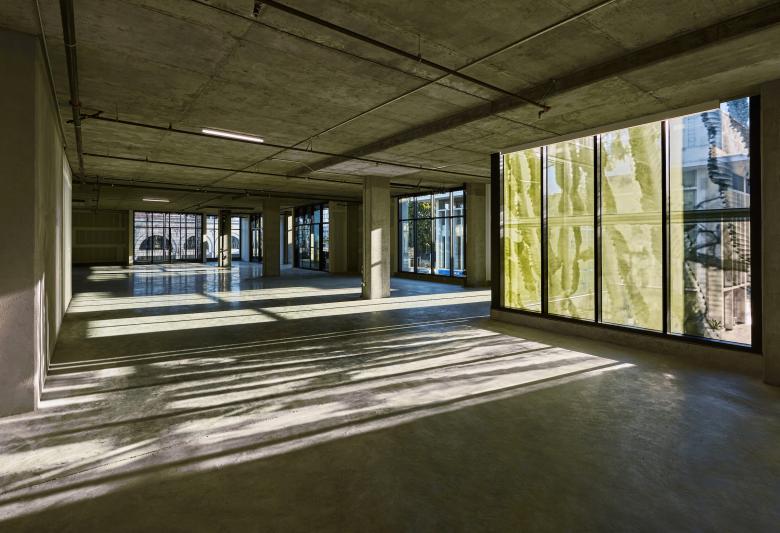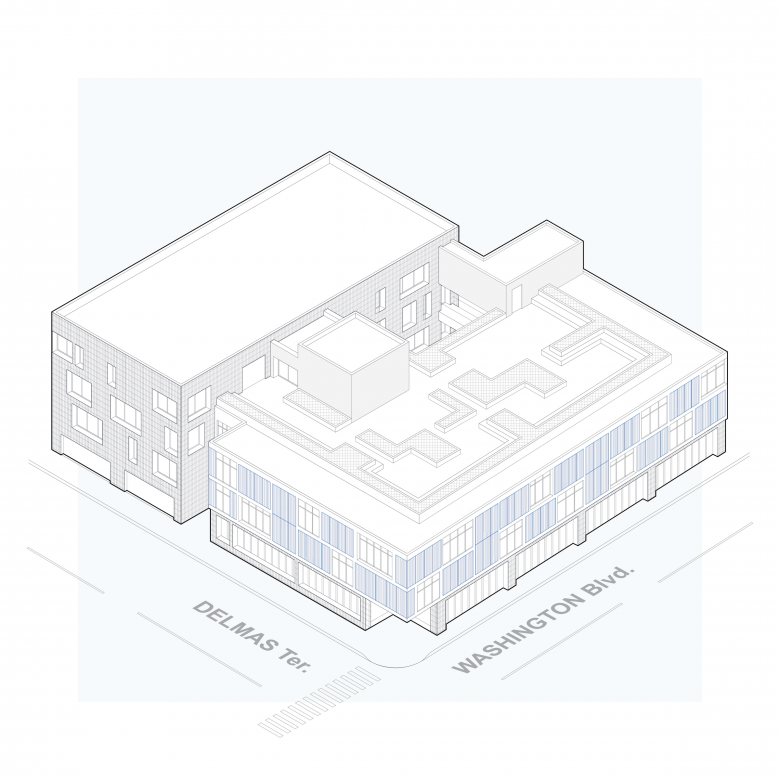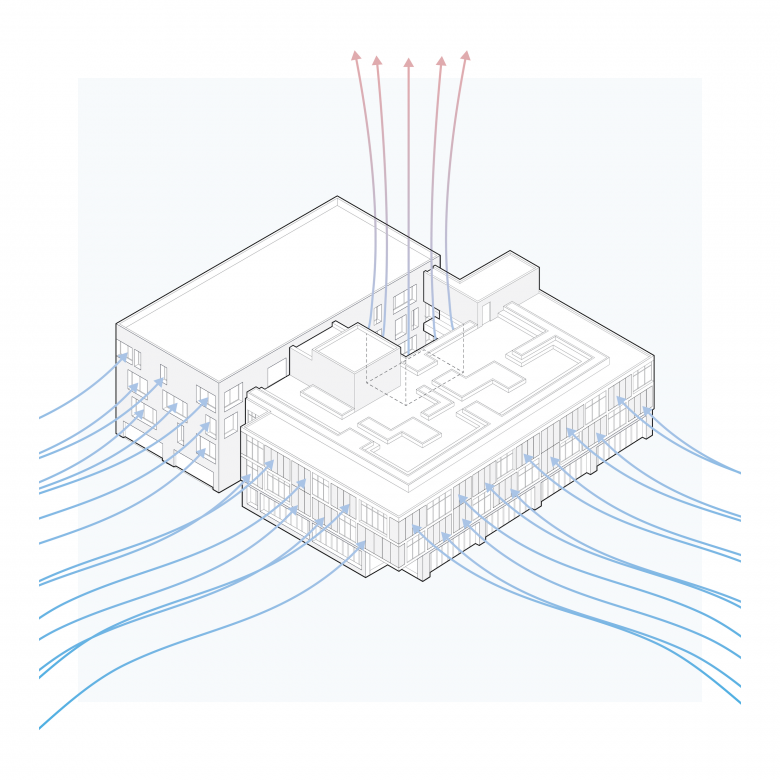US Building of the Week
The Brick + The Machine
Subsequently leased to a famous tech company, The Brick + The Machine was designed as a speculative office development in Downtown Culver City. The name of the project reflects the palette of its three- and four-story halves, which arose from zoning constraints, among other considerations. Abramson Architects answered a few questions about the project.
Location: Culver City, California, USA
Client: Clarett West Development, DLJ Capital Partners
Architect: Abramson Architects
- Design Principal: Marco Marraccini
- Project Manager: Matt Loghmani
- Project Team: Ryan Novi, Akhil Mathew, Sasha Monge, Kendra Ramirez, Phil Wang
Building Area: 76,000 sf (Offices: 60,000 sf; Retail/Restaurant: 16,000 sf)
See bottom for list of consultants.
The architectural selection for 9735 Washington Boulevard was completed through a design competition held by the developers. Since the building did not have a named tenant during design, the architectural team explored the major drivers for attracting creative office tenants in the current commercial real estate market. As such, our team initiated a research-driven approach to create a concept that would attract top-tier tenants and engage their users for years to come. We created a set of guiding principles for all design decisions in support of three main drivers: Identity, Interaction, and Connection.
9735 Washington respectfully redevelops an underutilized 0.66-acre property on the west edge of Downtown Culver City. The site previously housed an abandoned single-story bank building and a surface parking lot. The new structure engages the creative energy of its cutting-edge inhabitants by providing two distinct office environments: The Brick and The Machine.
The Brick features a dynamic shift between large, building-scale window openings and a finely textured, human-scale materiality. The exterior facade is a contemporary interpretation of the local historic landmarks. The Machine features a series of movable exterior screens that offer glare and temperature control. The two distinct office environments are connected at the main entrance storefront through a large-scale public art installation by glass artist Veronika Kellndorfer.
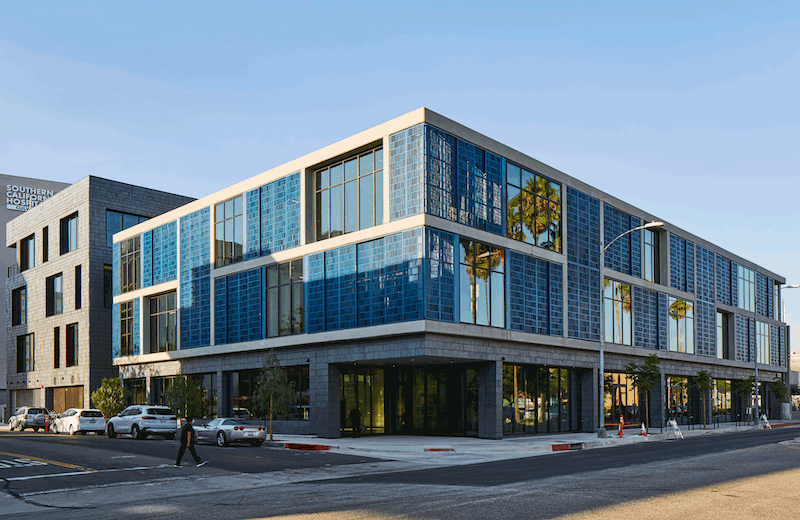
Photo: Sean Costello
What are the main ideas and inspirations influencing the design of the building?The Brick pays homage to the surrounding historic core, essentially a contemporary interpretation of the historic landmarks in the Culver City area. Bricks are used as an ornamental tile and again to create a 3D pattern that emulates ivy growth and provides variation and shadow play. This textured half of the project features a dynamic shift between large, building-scale window openings to a finely hewn, human-scale materiality.
The Machine features a series of small-scale exterior balconies equipped with operable full-height screens made from perforated aluminum. The punched metal panels offer visual privacy for the inset balconies while also providing cross ventilation through the building and into the central courtyard. The large, rolling metal panels span both the facade of the building and the open-air balconies, allowing their daily movements to add to the vitality of Downtown Culver City.

Photo: Sean Costello
The two distinct office environments are connected at the main entrance storefront through a large-scale public art installation by glass artist Veronika Kellndorfer. Once inside, The Brick and The Machine share expansive landscaped areas including a multi-story courtyard and an activated rooftop deck.
The central courtyard that connects the two environments brings natural light into the depth of the building. It also connects the different building volumes and levels with bridges and an external stair. The central courtyard provides protected private exterior space at a medium scale for small teams and group meetings and doubles as a light well bringing in natural light from the center of the building.
The Brick building's fourth floor becomes the backdrop for unexpected outdoor experiences, such as panoramic "golden hour" views during happy hour. Strategically placed planters aid in rainwater collection while instilling a meadow-like quality to the roof deck. The perimeter landscape creates the impression of walking within an elevated garden. A series of additional planter boxes help to break the garden's overall massing into various scales of human-centric outdoor spaces.
The building’s distinct identity embraces the area’s legacy architectural styles while overcoming multiple high-level design challenges. The site is located across from a busy triangular intersection to the south and a hospital on the north. The building footprint straddles two different city planning zones imposing a three-story limit on one side of the property and a four-story height restriction on the other.
Additionally, the location has a solar orientation that is 45% off of north. While this provides ample direct sunlight for inhabitants, careful attention would be required to mitigate the potential for excessive heat gain.
The result is a high-performance facility with easy access to restaurants, coffee houses, a renowned farmers market, art galleries, and the Culver City Metro Expo Station. This unique combination of small-town charm and urban comforts reduces the users' carbon footprint while increasing their community engagement.
Despite being under construction during the pandemic, the team successfully completed the project nearly two months ahead of schedule. The general contractor exceeded the schedule and mitigated COVID-related impacts to materials by creating long-lead items tracking to ensure all materials were delivered on-time. To maintain a safe environment for the workforce, the team implemented social distancing when onsite and collaborated with the City to conduct virtual inspections when shutdowns occurred. These activities were instrumental in maintaining the schedule of deck pours and closing walls required for an on time delivery to the client.
The Brick and Machine was fully leased to Apple before completion.
Because of the building's orientation, various solar shading options were researched, tested, and evaluated. The resilient office building sustains thermal exposure without fluctuations in heat gain thanks to a combination of passive and active energy solutions. A series of inset balconies provides cross ventilation through the building and into the central courtyard while the manually controlled sliding panels further enhances the passive cooling system. The manually controlled sliding panels give users the option to control their immediate surroundings without burdening the building’s HVAC system.
In keeping with the low environmental impact goals for the project, a rooftop garden enhances the traditional roof deck. This option adds a layer of insulation and allows for efficient use of rainwater runoff. The Brick + The Machine also promotes sustainability and alternative transportation through the inclusion of secured bike stalls, shared bikes, electric vehicle parking spaces, ride-share loading/unloading areas, on-site recycling collection, integrated solar panels, and operable windows.
Email interview conducted by John Hill.
- Contractor: Morley Construction Company / Benchmark Contractors, Inc.
- Structural Engineer: JLA Structural Engineers
- MEP/FP Engineer: Rex Engineering
- Landscape Architect: LA Group / Cactus Story
- Geotechnical Engineer: Geotechnologies, Inc.
- Traffic/Parking Consultant: Crain and Associates
- Parking Equipment Consultant: Sentry
- Waste Management: Terra Pacific Waste Management
- Elevator Consultant: Lerch Bates
- Waterproofing Consultant: Simpson Gumpertz & Heger
- CEQA Consultant: ESA-PCR
- Solar Panel Consultant: Xero Solar
- Security System: PlanNet Consulting
- Lighting Designer: Vince Tarango
- Facade Fabricator: Arktura
- Brick Manufacturer: Endicott Thin Brick and Tile LLC



